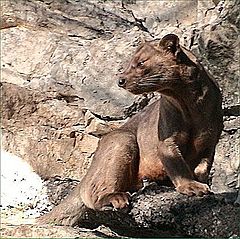Malagasy carnivorans facts for kids
Quick facts for kids Euplerids |
|
|---|---|
 |
|
| Fossa | |
| Scientific classification | |
| Kingdom: | |
| Phylum: | |
| Class: | |
| Order: | |
| Suborder: | |
| Family: |
Eupleridae
Chenu, 1850
|
| Subfamilies | |
|
Euplerinae |
|
The family Eupleridae is a special group of carnivores that live only on the island of Madagascar. There are eight different kinds of these animals, divided into seven groups (genera) and two main families. They live in many different places, from wet forests and swamps to dry deserts and savannas.
Euplerids are all related to each other, forming a special group called a clade. This means they all came from a common ancestor. Scientists believe their ancestors floated over from Africa on rafts of plants about 20 million years ago! They are close relatives of mongooses. The fossa and the Malagasy civet (Fossa fossana) are thought to be the oldest types of Euplerids still alive today.
These animals usually have thin bodies and fairly small heads. Their bodies, not including their tails, can be from about 250 mm (10 inches) to 800 mm (31 inches) long. Euplerids mostly eat meat, like small mammals, birds, reptiles, frogs, insects, and other small creatures. Some, like the Malagasy civet and the ring-tailed mongoose (Galidia elegans), might also eat some fruit.
Reproduction and Family Life
Euplerids have specific times of the year when they have babies. Each species' breeding season is different and can last from two to eight months.
Fossas often live in pairs that stay together for life, which is called monogamous. Other species, like those in the Galidia, Mungotictis, and Salanoia groups, might live alone or in pairs. This suggests they might only stay together for one breeding season.
Some Mungotictis individuals live in small groups with several adult males and females. However, scientists are not sure if all the adults in a group have babies. Cryptoprocta (which includes the fossa) usually live alone. This suggests they might have a mating system where one male mates with many females, or where both males and females mate with multiple partners.
After mating, the mother's pregnancy lasts about three months. Usually, only one or two babies are born at a time. However, fossas can have up to four babies in one litter. The young animals drink their mother's milk until they are between two and four and a half months old. This process is called weaning.
Protecting Euplerids
Sadly, all species in the Euplerid family are currently facing threats. The biggest problems are that their homes (habitats) are being destroyed and they are hunted by humans or dogs. Organizations like the IUCN (International Union for Conservation of Nature) are working to protect these unique animals.
See also
 In Spanish: Eupleridae para niños
In Spanish: Eupleridae para niños

